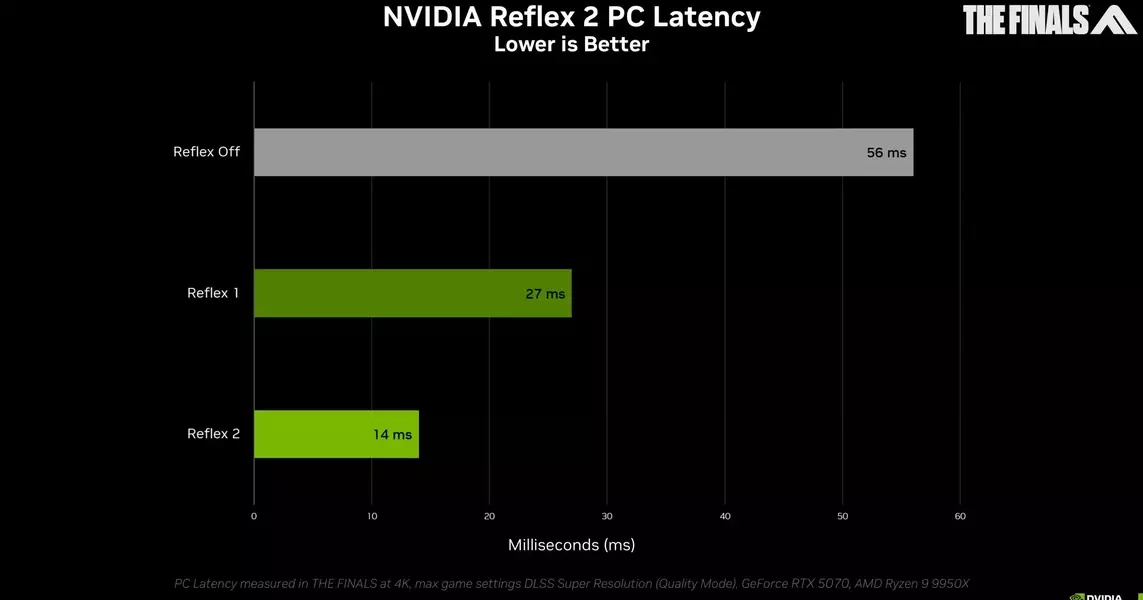NVIDIA Unveils Revolutionary Reflex 2 Technology to Transform Gaming Experience

The gaming industry is set for a major transformation with the introduction of NVIDIA Reflex 2. This advanced technology promises to significantly reduce latency, enhancing player performance in over 100 games. By integrating Reflex Low Latency mode with Frame Warp technology, Reflex 2 can decrease latency by up to 75%. The technology updates rendered frames based on the latest mouse input, providing players with faster and more responsive gameplay. During CES 2025, NVIDIA demonstrated Reflex 2’s capabilities using Embark Studio’s The Finals and showcased its effectiveness in reducing latency from 56ms to just 14ms on an RTX 5070 GPU at 4K resolution. Additionally, Reflex 2 excels in CPU-limited scenarios, as seen in VALORANT, where latency drops to under 3ms on an RTX 5090. This innovative tech will debut alongside GeForce RTX 50 series GPUs.
Revolutionizing Gameplay Responsiveness with Advanced Frame Manipulation
NVIDIA Reflex 2 introduces a groundbreaking approach to improving gameplay responsiveness through its Frame Warp technology. This feature dynamically adjusts rendered frames to reflect the most recent player inputs, ensuring that actions are displayed almost instantly on screen. The result is a smoother and more intuitive gaming experience, allowing players to react faster and perform better in fast-paced environments. The technology achieves this by predicting and adapting the camera position of each frame based on real-time input, ensuring that every action feels immediate and precise.
In-depth analysis reveals that Frame Warp operates by leveraging both the GPU and CPU to optimize frame rendering. As the GPU renders a frame, the CPU simultaneously calculates the anticipated camera position for the next frame based on player movements. At the final stage of rendering, the Frame Warp technology samples the new camera position and warps the existing frame to match this updated perspective. To address potential gaps in the image caused by this adjustment, NVIDIA has developed a predictive rendering algorithm. This algorithm uses data from previous frames to accurately fill any holes, ensuring a seamless visual experience without compromising on latency reduction. The end result is a highly responsive and visually coherent game environment that enhances player performance and enjoyment.
Enhancing Performance Across Diverse Gaming Scenarios
NVIDIA Reflex 2’s impact extends beyond high-end hardware configurations, offering significant improvements in various gaming scenarios. In particular, it excels in CPU-limited situations, where traditional rendering methods often introduce noticeable delays. Reflex 2’s Frame Warp technology effectively mitigates these delays, delivering near-instantaneous feedback even in demanding conditions. This makes the technology particularly valuable for competitive multiplayer games, where milliseconds can make all the difference. The versatility of Reflex 2 ensures that players across different hardware setups can benefit from reduced latency and improved responsiveness.
To illustrate its effectiveness, NVIDIA demonstrated Reflex 2 in action during CES 2025 using Embark Studio’s The Finals. On an RTX 5070 GPU running at 4K resolution with maximum settings, latency was reduced from 56ms to just 14ms when Reflex 2 was enabled. Similarly, in VALORANT, which will soon support Reflex 2, latency dropped to an impressive average of under 3ms on an RTX 5090, even at extremely high frame rates. These results highlight the technology’s ability to deliver consistent performance improvements across a wide range of gaming environments. Moreover, Reflex 2 will initially launch with the GeForce RTX 50 series GPUs, with plans to extend support to other RTX GPUs in the future. This widespread availability ensures that more players can experience the benefits of this cutting-edge technology.